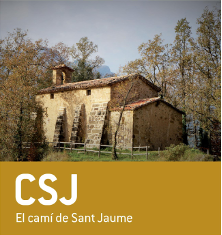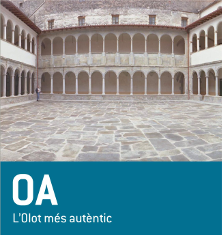15 proposals for you to discover the rich heritage of La Garrotxa
Be enthralled by the rich heritage of La Garrotxa.
The landscape of La Garrotxa has been modelled throughout history by nature and humans. The volcanoes, the basaltic cliffs, the paths and many constructions comprise a unique heritage of immense value which you can now enjoy through 15 proposals. They will offer you the chance to travel back in timeand get to know the cultural and natural heritage of the comarca of La Garrotxa. Enjoy the experience!
Here you will find 15 proposals for you to discover the rich heritage of La Garrotxa.
Discover Garrotxa Cultour following the proposals, games and challenges you will find in the APP, a tool which will lead you to some of the most interesting spots, apart from the ones you will find signposted along the route.
The Jewish quarter of Besalú stood next to the river Fluvià for over 500 years and its history lives on in the rich heritage it has left behind. Its story is the principal theme of this route, which provides visitors with a chance to learn more about Jewish culture. It runs through the squares and streets of medieval Besalú, across the bridge that provides access to the town, along the streets of Pont Vell, Tallaferro and Portalet, and visits the house of Astruc, the Cúria Reial and, finally, the Jews’ Square, where the synagogue once stood and from where steps lead down to the purification baths or ‘Mikveh’. These baths are one of the few 12th century Mikvehs still in existence, a fact that fully justifies their status as a valuable part of national heritage.
The St James’ Way runs through the county of La Garrotxa and visits en route a number of interesting sites. The most popular and accessible section runs between Les Planes d’Hostoles and Els Hostalets d’en Bas and shares a route with the greenway that follows the old railway line from Olot to Girona and Sant Feliu de Guíxols. Another of the St James’ ways follows the Via Ànnia, which originated in the county L’Empordà and followed the river Fluvià inland into La Garrotxa via Besalú, Castellfollit de la Roca and Sant Joan les Fonts.
This route explores the village of Santa Pau, blessed with a rich heritage – part of which is included on other routes – that stretches back to medieval times and the Remences peasant’s revolt and up to the 19th century Carline Wars. The route starts in the village itself and then heads for locally well-known sites such as the Pedra del Diable menhir and the waterfall of Can Batlle, before passing by some of the many isolated churches hidden away in the surrounding forests and mountains that include the Sanctuary of Santa Maria dels Arcs and the church of Sant Martí Vell. Finally, it visits the volcanoes and the D’en Jordà beech forest that lie in the heart of La Garrotxa Volcanic Zone Natural Park.
From the volcanic rocks used for roads, buildings and parks, the Olot School of Art and its paintings of the local volcanic landscapes, and today’s volcanic cuisine, the volcanoes have left their mark on how the city of Olot and its inhabitants have evolved. This route begins with a visit to the Museum of La Garrotxa in the Hospice building and then heads for the narrow streets in the heart of the old city. It then climbs three volcanoes – Montsacopa, Montolivet and Les Bisaroques – and explores the old watchtowers that still provide highly varied views over the city. The route ends with a stroll through the marshy woodland of La Moixina and the rugged Bosc de Tosca, and a visit to the excellent Espai Cràter.
The volcanoes that erupted thousands of years ago in what today is La Garrotxa region gave rise to great lava flows that occupied the bottoms of the local river valleys. Over time, this volcanic rock has been sculpted and eroded by water, cold and heat into a spectacular line of cliffs and other singular geological sites. Sant Joan les Fonts and Castellfollit de la Roca are the municipalities with the most spectacular and well known lava flows, but there are others in some municipalities of the volcanic region of Olot.
This route takes us back 500 years to when many Catalan serfs, oppressed by slave-like feudal laws known as the mals usos, took up arms against their feudal lords. It retraces the story of the Revolta dels Remences, the uprising led by its best-known figure, Francesc de Verntallat. It visits sites in the southern part of La Garrotxa closely associated with this period that include the castles of Hostoles and Puigpardines, the churches of Sant Salvador and Finestres, the Jonquer house and the Conqueta flourmill in the villages and mountains.
La Garrotxa is a county that is associated with a great variety of art forms. This route begins in Olot with a visit to the Museum of La Garrotxa, which houses the most important works of the Olot School of Landscape Art, for example those of the Vayreda brothers, as well as sculptures by Josep Clarà and Miquel Blay. It continues through the streets of the city, before heading for a number of villages from the Vall d’en Bas to Tortellà that host sculptures, buildings and even public parks that add to the county’s artistic richness and complement its historical, scenic, cultural and gastronomic riches.
Catalonia is one of the regions of Europe in which Art Nouveau – or Modernism, as it is known locally – took deepest root, above all as a result of the burgeoning economic, cultural and political power of the new Catalan bourgeoisie who used it to demonstrate its financial power and show off its artistic tastes. After the Romanesque, this is the best-represented artistic style in La Garrotxa and, above all, in Olot. This route begins with a stroll through Olot to visit Art Nouveau buildings such as the Ferrer patisserie and the Pujador and Escubós houses, before continuing on to other towns such as Sant Feliu de Pallerols and Les Planes d’Hostoles that also bear witness to this remarkable creative urge.
The Roman Road consists of two very different sections. The first stretch lies in the municipality of Castellfollit de la Roca and follows what are thought to be the remains of the Roman road that passed through Besalú. No further traces are found until the Bianya Valley, where a second stretch links Sant Salvador de Bianya and Sant Pau de Segúries via the pass of Capsacosta, in all 6.2 km of Roman road and a climb of 420 m. This section of Roman road branched off the great Via Augusta and headed inland and then breached the Pyrenees, probably at Coll d’Ares.
Although some structures from the 11th century do still stand, most of the surviving medieval buildings in La Garrotxa date from the 12th and 13th centuries. What remains of local Romanesque architecture in La Garrotxa – unfortunately, generally only recently reformed church apses and other buildings – closely follows the dictates of 12th century Romanesque architecture. Nevertheless, La Garrotxa still harbour examples of traditional Romanesque art including structures and other buildings built in Lombard styles, as well as other more elaborate examples of Romanesque art.
Art, history, volcanoes, Carline Wars — there are many elements that define Olot, a city that, despite over 1000 years of history, conserves almost nothing of its past due to the terrible earthquakes in 1427 and 1428 that all but destroyed the city. We walk through the old and new cities, climb the volcano of Montsacopa and explore the landscapes of La Moixina frequented by the Olot School of Landscape Art, and then visit some of the city’s most notable buildings including the Museum of Saints, whose long tradition of manufacture of religious icons has made Olot famous throughout the world.
This route takes us to 14 viewpoints that afford truly singular views – but often only after a stiff walk! – over some of the county’s most exceptional landscapes. They provide many different perspectives, from the tip of the basalt cliff of Castellfollit de la Roca, with its excellent views of the mountains of L’Alta Garrotxa and the river Fluvià as it drains east towards the sea.
This route visits the factories, canals, chimneys and other relics that provide a reminder of the industrial past of La Garrotxa. The route travels back through time to the pre-Industrial Revolution flourmills and then visits further vestiges of the county’s economic development and industrialization that took place at the end of the 19th and beginning of the 20th centuries. The route follows the two main rivers that flow through the county – the Fluvià to the east of Olot and the Brugent in the Hostoles valley – whose waters powered the industries that sprung up on their banks.
This route visits some of the sites in La Garrotxa that are indelibly associated with the Third Carline War (1872–1876). We are accompanied by the words of Marià Vayreda (Olot, 1853–Barcelona, 1903), a local writer who not only personally experienced the stories that we relate but also wrote about them some years later in his book Records de la darrera carlinada (‘Memories of the last Carline War’). La Garrotxa was one of the foci of this Carline War in Catalonia and witnessed episodes such as the Battle of Tortellà on 23 August 1873, the Battle of Toix on 14 April 1874 and the fall of the city of Olot to the Carline army – who held the city for almost a year – just two days later.
Monasteries, medieval villages, churches and, above all, castles are today some of the most important reminders of the medieval past of La Garrotxa. Throughout the county still stand the remains of castles such as the fortress of the lords of Montpalau in Argelaguer and that of Puigpardines. Many of the county’s villages date from this time: Santa Pau is an excellent example of a medieval village that sprung up in the protective shadow of the lord’s castle (in this case, belonging to the Barons of Santa Pau), while Sant Feliu de Pallerols, Riudaura and Tortellà all grew up as a sagrera, the area within a radius of 30 paces around a church in which people could take refuge from the abuses of their feudal lords..
More details
























